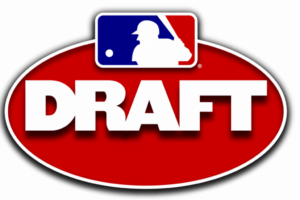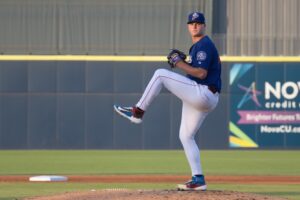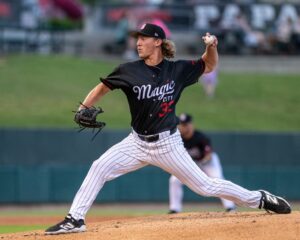“The Untouchables:” An analysis of the potential young centerpiece to a Chris Sale trade
Here at FutureSox, our focus is on the White Sox farm system and the prospects that populate the affiliates. However, similar to our Draft Preview articles, when there is an opportunity to forecast a select few special players the Sox may be eyeing, we are up for the challenge. Multiple national insiders have long speculated on what a Chris Sale trade would look like, what teams might be involved, and exactly what type of monster return it would garner. As the White Sox open the Winter Meetings, I believe the Sox are focused on acquiring one of a group of elite young players if they were to trade Sale. Inspired by a Ken Rosenthal’s article, I present to you, “The Untouchables.”
Houston Astros: Alex Bregman
The Astros selected Bregman #2 overall in the 2015 draft thanks to the good fortune of receiving a compensation pick for failing to come to terms with their 2014 first round pick, Brady Aiken. Bregman was a model of consistency at LSU, hitting for high average and power, maintained a patient approach with a high OBP, and flashed speed and a decent glove at shortstop. There was very little doubt that Bregman’s bat would play, but the big question was where he would stick defensively. The Astros kept him at his home position of SS in 2015, and he feasted on A-Ball pitching to the tune of .294/.366/.415 in his age 21 season. The Astros aggressively promoted Bregman to AA to start 2016 and he responded by improving upon his 2015 numbers at the higher level. The Astros now felt confident enough in Bregman to throw a position change his way, having him split time at third base. Many draft prognosticators believed that Bregman would eventually end up at second base and he regularly received Dustin Pedroia comparisons. However, his arm and shortstop range has translated well to the hot corner. After an 18-game tear through AAA Fresno, the Astros called up Bregman on July 25th, completing his meteoric rise through the system. After a slow start, the rookie ended the season by hitting .323/.344/.629 over his last two weeks.
If acquired, the White Sox could theoretically plug and play Bregman at 3B, SS, or 2B. Unlike many previous White Sox prospects, Bregman has elite ball-to-ball skills (68 K’s over 679 minor league PA’s) and showed tantalizing power (.497 SLG %). At the tender age of 22 and under club control until 2023, Bregman would be a cornerstone of the White Sox lineup and a key building block of their roster rebuild.
Atlanta Braves: Dansby Swanson
Swanson was taken one pick ahead of SEC rival Bregman, as he went #1 overall in the 2015 draft to the Arizona Diamondbacks. Swanson took a round-a-bout way to the #1 selection, as he played sparingly as a freshman, then was relegated from his natural position of shortstop to second base his sophomore year. However, his junior year he truly broke out, improving his numbers across the board while playing very strong defense at SS. After being drafted, Swanson was struck in the face by a pitch during a simulated game and missed over two weeks with a concussion. Despite the setback, Swanson had no trouble with at Low A Ball as he posted a .289/.394/.482 line over 22 games. Then on December 8th, the Diamondbacks did something unprecedented: they inexplicably traded Swanson, their #1 overall pick just months prior, to the Atlanta Braves in the infamous Shelby Miller deal. Immediately lauded as a horribly one-sided trade, Swanson’s play did nothing to dispel that notion as he tore through A+ Carolina over 21 games, slashing .333/.421/.526. The Braves promoted him to AA and his bat cooled down a bit, but still stuffed his stat line with 8 homers, 5 triples, and 13 doubles over 84 games. The Braves apparently saw enough of his work in the minors and skipped him right over AAA with a big league promotion on on August 17th. Some doubted this move, citing his work in AA didn’t properly prepare him for MLB pitching. However, Swanson once again silenced the critics and hit .302/.361/.442 over the last 38 games of the season for the Braves.
Unlike Bregman, who was bought up in a playoff race, Swanson never had to move off of his defensive position of shortstop. By all accounts, he shouldn’t have to anytime soon. Swanson plays a plus shortstop with freakish footwork and exceptional fundamentals. At the plate, he possesses a strong hit tool, good pop, and controls the strike zone very well. He is not the pure hitter that Bregman is, he has a little more swing and miss (17% K rate in the minors), and will likely hit for less power (.437 SLG % in minors). But Swanson is a safe bet to maintain a high average, get on base consistently, hit double digit home runs, and steal 20-30 bases, all while playing plus defense at a premium position. In other words, Swanson is a future perennial All-Star.
Boston Red Sox: Andrew Benintendi
Benintendi is the third player we are highlighting from the 2015 draft, as the University of Arkansas outfielder was taken 7th overall, one pick before the White Sox selection (Carson Fulmer). Despite being in the same conference and draft class as Bregman and Swanson, it was Benintendi who won the 2015 SEC Player of the Year Award and National Player of the Year Award thanks to an unbelievable .376/.488/.717 line. The power was especially surprising, as he only had one home run the previous year. Benintendi had little trouble transitioning to the pro ranks and assaulted A-Ball pitching to the tune of .313/.416/.556 over 54 games. After continuing his dominance in 2016 at the Advanced-A affiliate, Boston promoted Benintendi to AA Portland where he slashed .295/.357/.515 before being called up to the big league club on August 2nd. Like Swanson and Bregman, Benintendi was not overwhelmed and hit .295/.359/.476 over the last 34 games of the season for the Red Sox.
Benintendi has a smooth left-handed swing that creates vicious bat speed thanks to incredibly strong wrists. At 5’10”, 170 pounds, he doesn’t look like your prototypical power hitter, but he has posted a .200 or better isolated power number at every pro stop. The power is an added bonus to an elite hit tool that should ensure him hitting for a high average in years to come. Defensively, Benintendi is a solid-average center fielder who is above-average on the corners, which is where he mostly played in Boston with All-Star Mookie Betts patrolling center. If the Sox were to acquire him, he would immediately become their center fielder for the foreseeable future.
Washington Nationals: Trea Turner
At the ripe age of 23 years-old, Trea Turner is the elder statesman of this group. Following in the same mold as the players above, Turner was a highly productive college player taken in the (2014) first round. Turner fell to the Padres at the 13th overall pick, largely thanks to declining collegiate stats. After swiping 57 bags his freshmen year, and slashing .368/.455/.553 as a sophomore, he had a disappointing junior season, “only” hitting .321/.418/.516 and stealing 26 bases. However, Turner came on the pro scene running, hitting .323/.406/.448 with 23 steals in 69 games between two Class A affiliates. In the off-season following the 2014 season, the Padres decided to trade Turner (as a PTBNL) in an 11 player, three team mega deal for a package centered around Tampa Bay Rays’ Wil Myers. Washington Nationals GM Mike Rizzo shrewdly got involved and complimented the Rays package with outfielder Steven Souza and LHP Travis Ott and in return acquired Turner. Because MLB had rules against officially trading draft picks within their first year of in an organization (a rule that was changed and coincidentally allowed Swanson to be dealt a year later), Turner spent 58 presumably uncomfortable games with the AA San Diego affiliate to begin the 2015 season. The discomfort was likely on the part of the San Diego organization, because Turner slashed .322/.385/.471 and at some point they had to realize they made a terrible mistake. Once officially traded, the Nationals quickly promoted Turner to AAA where he continued to rake and eventually earned an August major league call-up. Turner began the 2016 season back in AAA, where he predictably flourished, but for the first time in his pro career he began playing center field; position change that foreshadowed a major league call-up in June. Turner split time between second base and center field, the latter a position the Nationals have penciled him into for the 2017 season. Wherever he played, Turner was a revelation offensively, hitting .342/.370/.567 with 33 steals over the second half the season.
Turner has always been a proverbial tool shed of talent and his impact is tremendous when he is able to put it all together. Some clubs (erroneously it seems) labeled him a speedster with just an above average hit tool and little power, but Turner has shown himself to be capable of much more. He has a level, simple swing that allows him to spray line drives to all fields. His power surge with the Nationals (.567 SLG) he has attributed to additional muscle and batting cage work to give his swing some additional loft. I have seen his power graded at as low as 35 (20-80 scouting scale), but his outburst has even his most staunch advocates surprised. In addition to his bat, Turner is most dangerous when he is on base and can use his foot speed to create havoc. He possesses 70-grade speed and could easily swipe 30-40 bags a year if he so chooses. Defensively, scouts agreed that he would stick at shortstop, so it is a bit controversial that the Nationals placed him in center field at the expense of light-hitting Danny Espinosa. At either premium position of SS or CF, Turner’s speed, hit tool, and especially his developing power is a boon to any club’s lineup.
While there are continuing reports that the Nationals are hot in pursuit of Sale’s services, no other player on this list presents more value to their current team than Turner.
Los Angeles Dodgers: Julio Urias
20 year-old lefty Julio Urias is the only pitcher on this list and took a completely different track altogether. Instead of crushing college competition and being a highly sought after draft pick, Urias was discovered as a 15 year-old by the Dodgers thanks to a strange twist involving Yasiel Puig. In June of 2012, Dodgers scouting director Logan White and a contingent of scouts where in Mexico City attending future Dodger Yasiel Puig’s showcase. Since they were in Mexico already, they decided to check out another showcase two hours south, in Oaxaca, Mexico. There they discovered “The Phenom” Urias, and the rest is prospect history. After posting a 2.48 ERA with a 11.1 K/9 as a 16 year-old in A-ball, Urias has gradually climbed the organizational ladder, culminating in a three affiliate jump in 2015 where he finished at AAA. In 2016 as a 19-year old he was simply toying with AAA hitters, posting a 1.40 ERA over 45 innings. As contenders and recognizing Urias was ready, the Dodgers called him up for his first start in late May. Los Angeles carefully handled his innings, having him skip starts and never allowing him to go more than six frames in any one start. Urias pitched two shutout innings in relief during the first post-season series against the Washington Nationals and earned a start against the Chicago Cubs in the NLCS. Overall, he finished 2016 with a 3.39 ERA over 77 major league innings while striking out 84 batters.
Urias has a smooth, repeatable delivery that looks effortless with easy arm action. His arsenal begins with a 60-grade fastball that he throws between 91-95, topping out at 97 if he rears back. That is excellent velocity for a left-hander, especially one with a bit of a deceptive delivery that often fools hitters. He commands his fastball well and does a good job keeping it down in the zone, working both sides of the plate with some natural cut. After his fastball, Urias features a plus 82-85 MPH change-up that flashes plus-plus. Urias conceals his change-up extremely well with his arm speed and it features lots of movement that makes it a true swing and miss pitch. Additionally, Urias has low 80’s plus curveball that has he shown enough touch and feel for that he can manipulate it from a three-quarters sharp break to a more rolling traditional curveball. He has also flashed a short slider that he reportedly has been working on, though the jury is still out if that will be a viable fourth offering for him.
Entering the 2017 season, Urias is a #2-3 starter with lots of room for projection. At such a young age (he won’t be old enough to drink legally until August of 2017), he is still growing physically, and of course adapting to the game at the highest level mentally. With three plus offering and a great delivery, Urias’ upside is an ace who could effectively replace Sale’s spot in the rotation for years to come.
Summary
All of these players are incredibly young, talented, and major league ready. It is easy to see why their respective organizations hold them in such high regard and publicly dismiss that they are considering trading them. However, it is also extremely uncommon that a true ace of Sale’s caliber is made available, and even rarer that he has such a paltry salary spanning multiple years of control. The White Sox have every right to ask for an historic haul and have their sights set on a elite centerpiece. While it is entirely possible that they will be rebuffed and either keep Sale or settle on a smorgasbord of lower level prospects, one of these “untouchables” may become the face of a new chapter for White Sox baseball in the years to come.
Want to know right away when we publish a new article? Type your email address in the box on the right-side bar (or at the bottom, if on a mobile device) and click the “create subscription” button. Our list is completely spam free, and you can opt out at any time.






